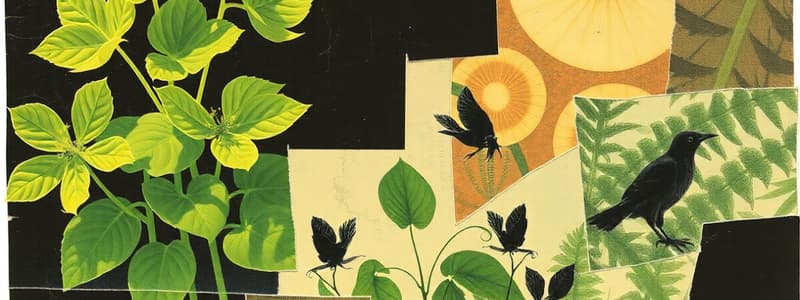Podcast
Questions and Answers
What happens to the rate of photosynthesis when temperatures increase beyond a certain point?
What happens to the rate of photosynthesis when temperatures increase beyond a certain point?
- It levels off and remains constant.
- It fluctuates unpredictably.
- It continues to increase indefinitely.
- It decreases due to enzyme denaturation. (correct)
What is a limiting factor in the process of photosynthesis?
What is a limiting factor in the process of photosynthesis?
- The amount of light that reaches a plant. (correct)
- The color of the plant's leaves.
- The temperature of the environment.
- The type of soil used for growth.
What role does oxygen play in the process described in the experiment?
What role does oxygen play in the process described in the experiment?
- Oxygen indicates the volume of water consumed by the plant.
- Oxygen serves as an energy source for the plant.
- Oxygen acts as a byproduct, demonstrating photosynthesis activity. (correct)
- Oxygen is a reactant in photosynthesis.
Which statement accurately describes the relationship between light intensity and the rate of photosynthesis?
Which statement accurately describes the relationship between light intensity and the rate of photosynthesis?
Which factor is NOT mentioned as a controllable variable in the experiment?
Which factor is NOT mentioned as a controllable variable in the experiment?
In an experiment measuring the oxygen production of a plant, what is the role of the capillary tube?
In an experiment measuring the oxygen production of a plant, what is the role of the capillary tube?
In a graph showing a limiting factor, what does it indicate when the curve levels off?
In a graph showing a limiting factor, what does it indicate when the curve levels off?
As carbon dioxide concentration increases, what occurs in the rate of photosynthesis?
As carbon dioxide concentration increases, what occurs in the rate of photosynthesis?
How can farmers utilize the knowledge of limiting factors in order to improve crop yields?
How can farmers utilize the knowledge of limiting factors in order to improve crop yields?
What does a graph with three limiting factors indicate?
What does a graph with three limiting factors indicate?
Flashcards
Photosynthesis Rate
Photosynthesis Rate
The speed at which plants produce glucose through photosynthesis.
Limiting Factor
Limiting Factor
An environmental condition that slows down photosynthesis, even if other conditions are perfect.
Temperature Effect
Temperature Effect
Higher temperatures increase photosynthesis initially, but excessively high temperatures cause enzymes to break down, decreasing photosynthesis.
Light Intensity Effect
Light Intensity Effect
Signup and view all the flashcards
Carbon Dioxide Effect
Carbon Dioxide Effect
Signup and view all the flashcards
Graph with One Limiting Factor
Graph with One Limiting Factor
Signup and view all the flashcards
Graph with Multiple Limiting Factors
Graph with Multiple Limiting Factors
Signup and view all the flashcards
Controlling Variables
Controlling Variables
Signup and view all the flashcards
Study Notes
Plant Structures and Their Functions
- Plants and algae are the primary producers in food webs and food chains, synthesizing food from sunlight through photosynthesis.
- Photosynthesis is an endothermic reaction, absorbing more energy than it releases, with the overall equation: carbon dioxide + water → glucose + oxygen
- Factors affecting the rate of photosynthesis include:
- Temperature: Enzymes control the reaction; increasing temperature boosts the rate until enzymes denature, decreasing the rate.
- Light Intensity: Higher light intensity generally leads to a faster rate; photons (light energy) hitting chloroplasts increase reaction rate.
- Carbon Dioxide Concentration: A higher concentration increases the rate; more CO2 is needed for glucose production.
- Any factor can become limiting: Even if other factors increase, the rate can't increase past the limit imposed by the limiting factor. This is evident on a graph by the curve flattening.
- A single-factor graph shows the limiting factor's effect on the rate, with the limiting factor on the x-axis and the reaction rate on the y-axis; multiple-factor graphs display multiple lines corresponding to different environmental conditions.
Core Practical: Light Intensity and Rate of Photosynthesis
- Design an experiment measuring a plant's oxygen production (rate of photosynthesis) using pondweed, a water bath, capillary tube, syringe, lamp, and ruler.
- The independent variable should be the distance of the lamp from the pondweed, while other variables (e.g., temperature, exposure time) are controlled.
Inverse Square Law
- Light intensity is inversely proportional to the distance squared from the light source (inverse square law): Light intensity = 1/distance².
Structure Adaptations
- Root hair cells: Specialized for water and mineral ion uptake, showing a large surface area for increased absorption and a large central vacuole, with mitochondria for energy.
- Xylem: Dead, lignified cells forming tubes for water transport; lignin provides support against pressure.
- Phloem: Living cells with sieve plates for transport of sugars (sucrose). Energy for this is provided by mitochondria in companion cells.
Transpiration and Stomata
- Transpiration is water loss from leaves.
- Stomata (pores) allow for gaseous exchange.
- Guard cells regulate stomata opening and closing, influenced by water levels and light availability.
Translocation
- Translocation is the movement of sugars (e.g., sucrose) through the phloem from source (where they are made) to sinks (where they are stored or used).
- Sources and sinks fluctuate depending on the time of year (e.g., roots in spring, leaves in summer).
Environmental Factors Affecting Water Uptake
- Factors affecting transpiration rate include temperature, humidity, wind speed, and light intensity.
Extreme Adaptations
- Plants in harsh environments (e.g., deserts) may have fewer leaves, modified leaf shape, and/or thick cuticles to minimize water loss.
Plant Hormones
- Hormones like auxins regulate plant growth and responses.
- Auxins: Stimulate cell elongation, influencing responses like phototropism (growth towards light) and gravitropism (growth responding to gravity).
- Gibberellins: Involved in germination, stem elongation, and fruit development.
- Ethene: Stimulates fruit ripening.
Commercial Uses of Plant Hormones
- Plant hormones find uses in agriculture, such as weed killers (e.g., auxin) and promoting growth or fruit development (e.g., gibberellins).
Studying That Suits You
Use AI to generate personalized quizzes and flashcards to suit your learning preferences.



